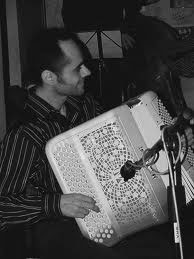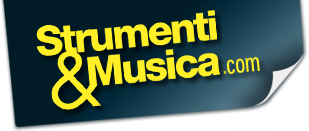 Saro Calandi graduated in clarinet at the Conservatory G. Verdi in Milan with Maestro L. Magistrelli. He studied accordion as self-taught and explores the techniques, participating in numerous workshops and master classes, both in Italy and abroad. In addition to a rich concert activity, through which he performed in important stages throughout Europe and collaborate with internationally renowned artists, he works as a composer and teacher, both clarinet and accordion. Both as a soloist and in collaboration with groups and artists with different music background, is confronted with a variety of musical genres, from jazz to classical, from folk to rock, to ethnic genres such as tango, flamenco etc.
Saro Calandi graduated in clarinet at the Conservatory G. Verdi in Milan with Maestro L. Magistrelli. He studied accordion as self-taught and explores the techniques, participating in numerous workshops and master classes, both in Italy and abroad. In addition to a rich concert activity, through which he performed in important stages throughout Europe and collaborate with internationally renowned artists, he works as a composer and teacher, both clarinet and accordion. Both as a soloist and in collaboration with groups and artists with different music background, is confronted with a variety of musical genres, from jazz to classical, from folk to rock, to ethnic genres such as tango, flamenco etc.
Your concert career began on the stage of dance music , and then articulated in the universes of jazz, rock, ethnic, classical. The accordion, then, is really a versatile instrument or is just a trandy that is coming back popular among young people?
I’ve moved my first steps with the accordion into mazurka. I think this kind of music, in Italian, is a stage for many young people who come to this instrument. It is a world of niche, mysterious, for those who do not know how many doors can open this instrument. Unfortunately, the lack of knowledge means that many people turn up their nose in front of the word “Accordion”. I do not agree when it comes to fashion: I think that this tool is always in fashion. Perhaps the new generation are realizing more and more of its potential and therefore is possible to use it in a variety of musical genres, certainly thanks to many world-renowned artists, all of Richard Galliano and Astor Piazzolla. The accordion for me is a great little orchestra, full of nuances, which has allowed me to roam between different styles.
The new generation of accordionists has been able to counter the skepticism and distrust that was leading among many musicians, who considered the accordion still not up and an instrument of series B. Your propensity and its roots in dance music have somehow hindered your artistic consecration ?
The dance music for me it was an excellent gym, a starting point for my career as a musician. I repeat the point: the accordion needs more awarness, that is, to leave by a certain intellectual isolation . Say “dance music”, for example, is sometimes seen as a way to diminish this instrument, with all the contradictions and distortions produced by this margin . Have you ever heard of the violin world champion? Or a trombone? Well, the accordion is there, and it is not good: define the world championships a music competition is a bit ridiculous. This means detract from the instrument. Rightly or wrongly, the accordion is confronted with a glorious but imperfect past: it is seen as a tool which can come only from a certain type of music and not others. When, however, can express many kinds.
Do you have a model? Are you inspired by any particular artist?
As a child I remember going to find at home the teacher Gigi Stocchi, aka Gigi Stok, and have felt great emotion performing his songs, being heard by him. For me Stok was an idol. I was impressed by his gesture and his sentence after only a few lines of his composition. He pulled my hand away from the keyboard and said: “First of all, you have to play with the heart…”. However, I have never been inspired by just a musician: listening to all kinds music, researching different sounds without focus only on the accordion world, preferring the ethno-folk. I love listening to singers: all instrumentalists have much to learn from their technique
From your trail emerges a strong inclination to study “do it yourself”, exept attending courses with institutions such as Frédéric Deschamps and Vladymir Zubytsky. What do you think of the current teaching programs and what kind of solutions you adopt with your students?
Artistically speaking I am a free spirit. As a child I used to play with the sounds of a piano researching little melodies. Today there are many schools of high standard, and that makes me think there is many students come from conservatives every year, maybe technically good but with a major flaw: the lack of originality. I do not want to generalize, but often listen to a talented pianist is like to listen 100 other pianists. A phrase that I say to my students is: the accordion is played with the body. It is a very physical instrument: it must be played with our body and, optionally, also with our soul. With the students I try to exploit the fact of making music from the beginning, even while dealing with the early technical difficulties without suffocating them too. Each student is different, has its qualities and characteristics. I think a teacher should be able to figure out what kind of student in front of him and thus encourage him. Another related problem is that the accordion competition must always make more notes from other instruments to prove its value, which for me , however, is indisputable.
How do you reconcile the timbre of the accordion with the synth, and the virtual groove typical of contemporary genres sound?
I prefer the traditional acoustic accordion, although occasionally use the Roland digital accordions, which I really enjoy. Honestly I think the digital accordion is just a diversion and not a replacement of traditional accordion. They are two different instruments, which give different emotions. I really like to mix electronic sounds with acoustic characteristics. I do not dislike any kind of instrument, either electronic or acoustic, and no type of sound source. The important thing is being able to use anything that can produce music. Exclude sounds it would like peel off colors in the palette of a painter.
You’ve chosen to play an instrument produced by Mengascini, one of the most famous handicraft factories in Castelfidardo. It is a choice linked to the versatility of the instrument and then the ability to use it in different contexts? Tell us about the characteristics and qualities of your accordion.
An article in the Corriere della Sera last year talking about me and the tuner Mengascini. The dialogue between him and me was described almost like a duel: my pedantry, when I put up an instrument, is almost manic. The accordion is a very complex instrument and every artist makes demands highly customized to the manufacturers, both from the aesthetic and the technical point of view. Unlike the piano, it has a tendency to choose the type of tuning, the stroke of the button, the lift of the reed. My choice was very meticulous: I came to Mengascini after having tried and tried tools of other manufacturers companies. I researched a particular sound, very refined, which would allow me to play different types of music. My accordion satisfies me, has a lot of sound elasticity, a very full tone. Sound research must reflect the moments of life.
What do you expect from an high quality standard instrument like yours?
Surely it must reflect my way of playing according to the state of mind, my character, my way of being. In a nutshell: it must accompany me.
You dedicated your whole self to the music, and especially the accordion, but the title who displays, among other things, developed at the Conservatorio Giuseppe Verdi in Milan, has a diploma in clarinet.
The music has helped me in the most difficult and delicate steps of my life. I realized that I would be a musician sonce I was a child. At the time the title was not recognized and there was not the possibility of studying accordion in Milan.
To close, the most classic of questions: what about next projects of multi-instrumentalist Saro Calandi?
I am enriched with artists such as Van De Sfroos and Antonio Canale. From 2013 I founded the “Oras Project”, named as a my own composition, finding my own musical identity. I do not know what the future holds for me. For sure, I know that the future will be a time of music and accordion.
Questo post è disponibile anche in: Italian

 English
English Italiano
Italiano 





Leave a comment
You must be logged in to post a comment.